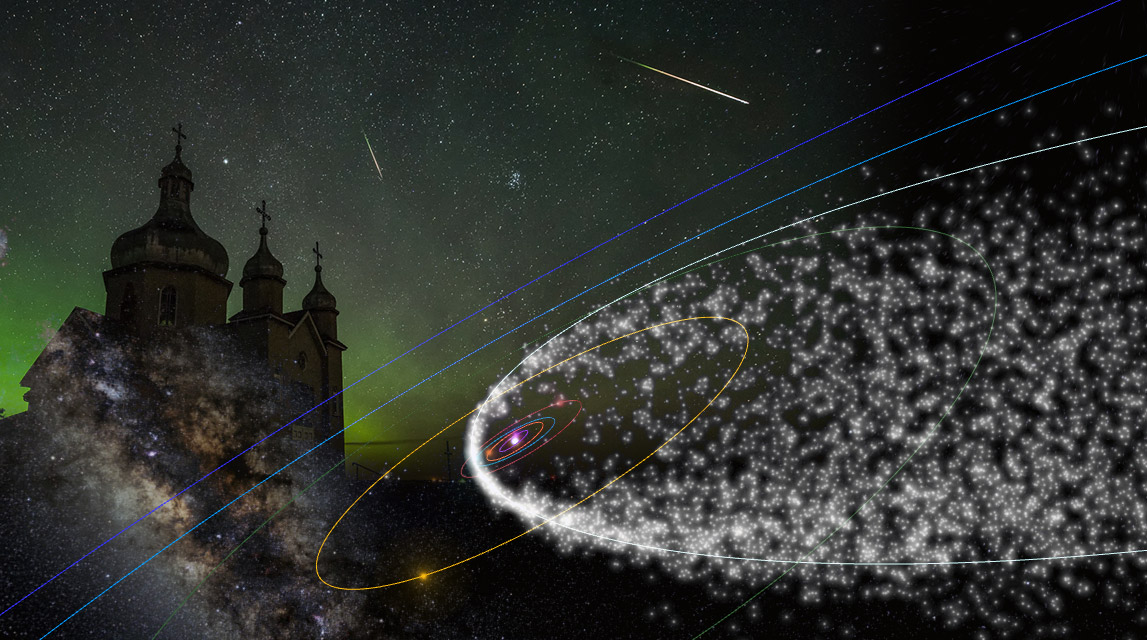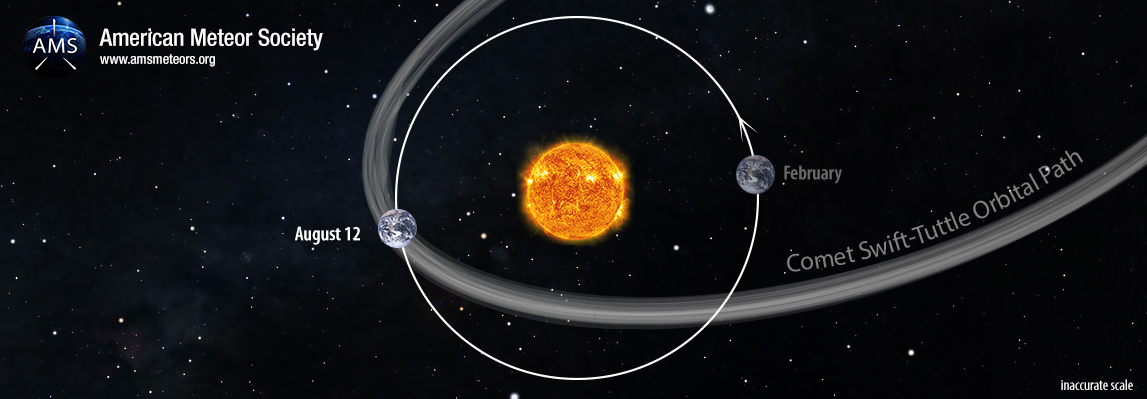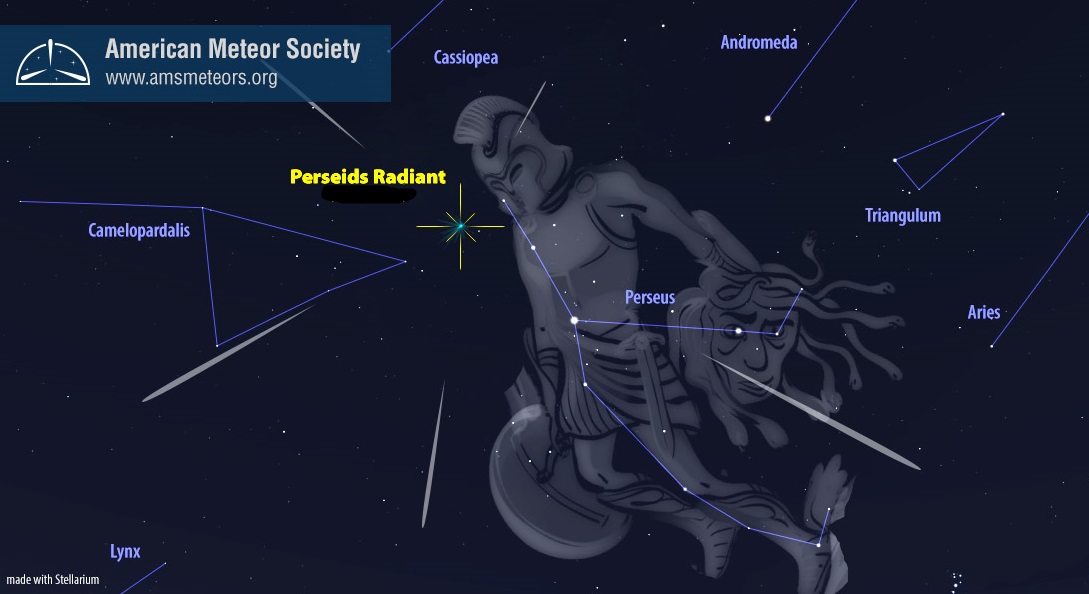
Comet Dust
Each July and August the Earth encounters debris left behind from comet 109P/Swift-Tuttle. This comet has an orbit of 133 years and last entered the inner solar system in 1992. Even though the comet now lies in the outer portions of the solar system, far away from Earth, we still encounter debris that has been left behind during the many trips this comet has made through the solar system.
This meteor shower is perhaps the most popular as it is active during the summer months in the northern hemisphere. There are stronger meteor showers but they appear during the colder time of year in the northern hemisphere when conditions are less inviting. The strength of each Perseid display varies year to year, mainly due to lunar conditions. If a bright moon is above the horizon during the night of maximum activity, then the display will be reduced. Most of the Perseid meteors are faint and bright moonlight will make it difficult to view. Such was the case in 2022 when a bright full moon spoiled the display. In 2024, a half-illuminated moon will have set by midnight, allowing dark skies to prevail the remainder of the night. This will make evening viewing difficult as faint meteors may be obscured by moonlight. After moonset, only local light pollution and clouds will reduce the number of meteors you will see.
August 11th / 12th
The Perseid maximum is expected to occur between the hours 13-16 Universal Time on August 12th. To view the Perseids at their best, you need to know when to watch. During the evening hours the radiant, the area of the sky where Perseid meteors shoot from, is located low in the northern sky. This is the worst time to try and view the shower for sheer numbers as most of the activity will occur beyond your line of sight, being blocked by the horizon. The few that do come your way this time of night are special. The reason is that they just skim the upper regions of the atmosphere and will last much longer than Perseids seen during the morning hours. Since they last longer they also will travel a much longer distance across the sky. Most of these “earthgrazing” Perseids will be seen low in the east or west, traveling north to south. Occasionally one will pass overhead and will be unforgettable as you watch it shoot across the sky for several seconds. While these meteors are few, they are certainly worth the effort to try and catch. This year though there will be a half-illuminated moon in the sky during the evening hours. This will further reduce the number of meteors seen.
As the Earth rotates and the time approaches local midnight, the Perseid radiant has risen higher into the northeastern sky. The meteors are now shorter and last only a few tenths of a second. You still only see about half of the actual activity as the remainder still occur beyond your line of sight below the horizon. As the morning progresses, the activity will increase as the radiant climbs higher into the sky. Theoretically, the best time to watch the Perseids is just before the break of dawn when the radiant lies highest in a dark sky. This is usually around 04:00 local daylight saving time. Experienced observers often say the hour between 03:00 and 04:00 is usually the best, not 04:00 to 05:00. Perhaps this is due to fatigue as observers have watched for several hours by then and may have trouble staying alert.

On Sunday night/Monday morning August 11/12, the Earth will pass closest to the core orbit of comet 109P/Swift-Tuttle. This is when the strongest rates occur. If this time coincides with the early morning hours at your location, you are in for quite a show. In 2024, the expected time of maximum will occur between the hours 13-16 Universal Time on August 12th. This corresponds to 9am-noon EDT and 6-9am PDT on the morning of August 12th. This timing is during the late afternoon for Europe and the daylight morning hours for North America. If you cannot observe on that night activity will still be good on the nights prior and after maximum. The further you watch from August 13th, the weaker the display will be. To view the Perseids successfully, it is suggested you watch from a safe rural area that is as dark as possible. The more stars you can see, the more meteors will also be visible. No matter the time of night, Perseid meteors can be seen in all portions of the sky. It is advisable to aim your center of view about half-way up in you darkest direction away from lights and obstacles such as hills and trees. Don’t look straight up as more activity is visible at lower elevations. Some observers like to view toward the constellation Perseus and the radiant. This way they can see Perseid meteors travel in all directions. The disadvantage of viewing in this direction is that the Perseid meteors will be short, especially near the radiant. The other choice is to face away from the radiant and witness longer meteors, which are more impressive. Many of the brighter Perseids will leave behind persistent trains which appear like smoke trails. Most of these trains only last a second or two but those lasting longer can appear to twist and turn as the winds in the upper atmosphere distort them. These trains are actually not smoke, but are the result of the meteor’s quick passage through the atmosphere where the air molecules are ionized, creating the glow we see as a smoky streak after the meteor has disappeared.
Not all meteors seen will be Perseids. There are minor showers active at this time that produce around 5 meteors per hour. There are also random meteors, not associated with any recognizable shower, that contribute up to 10 meteors per hour. These meteors are easily distinguished from the Perseids as they move in other directions compared to the Perseids and are usually slower. All Perseids, no matter where they appear in the sky, will trace back to the area of the radiant in the constellation of Perseus (see illustration below).
 Position of the Radiant on August 12th
Position of the Radiant on August 12thShare!
Viewing this meteor shower is fun, but one can also contribute useful scientific data on each meteor you see. We encourage observers to contribute data by counting the number of meteors seen during a specific time range and sharing that data with us. A period of at least an hour is suggested as meteor displays are notoriously variable. One can watch for 10 minutes and see no activity at all! Just a few minutes later several meteors may appear nearly simultaneously. To even out these “peaks and valleys” is why we ask for viewing periods of at least an hour. Not all meteors you see will be Perseids. There are other weak showers active during the Perseids plus there are many random meteors that occur each hour too. Separating these different meteors adds to the value of your data. It is also important to estimate the faintest star you can easily see by reporting a limiting magnitude. The faintest stars most observers can see from a rural location is around magnitude +6.0. Very dark sites can approach +7.0. Light polluted skies and skies with bright moonlight usually offer limiting magnitudes of +5.0 and lower. An estimate of your limiting magnitude will allow us to correct your data to a similar limiting magnitude so that all counts will be compared under similar conditions. Don’t forget to mention any clouds or obstacles that block your field of view. These will reduce your counts.
Blank meteor forms for your personal data are available here. To share your data we suggest filling out a form on the website of the International Meteor Organization, a partner with the AMS in meteor observations . You will need to register here, which is free. This will give you a lifetime profile page where your data is stored. Once you have a profile page you will have access to uploading you data on a summary page. We monitor observations shared with the IMO and you can too by visiting the Visual Campaigns.
The bottom line is to have fun watching nature’s fireworks. If you can have fun and contribute data too, that helps us understand more about this phenomena.
 American Meteor Society
American Meteor Society
Excellent detailed info. The local news folks are wrong. Telling people to look tonight (8-10). I’m usually up around 6, will try to be up a bit earlier!
Thank you Mr Lunsford for the excellent information on the Perseids meteors. I live in east Tennessee on a farm and my family is very excited to take part in this natural phenomena , with the weather expected to be perfect for viewing!
Christie and All,
I hope you enjoy the show!
Thank you for all the valuable information you’ve given me over the years. I even got to report a fireball the night of the aurora.